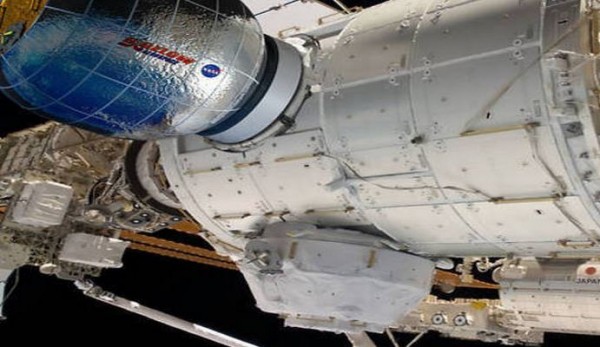Inflatable Space Station Module will be Attached to the ISS
| Arthur Dominic Villasanta | | Mar 16, 2015 09:10 AM EDT |
(Photo : NASA) Bigelow BEAM habitat (upper left)
An inflatable "hotel" that will one day be used to protect human colonists on Mars will be tested on the International Space Station in September.
The portable habitat, the Bigelow Expandable Activity Module (BEAM), measures 13 feet x 10 feet and is inflatable. It was unveiled over the weekend.
Like Us on Facebook
Once berthed to the ISS, BEAM will be used by astronauts as a lounge area where they can rest and stretch their legs. The habitat will also be used as a testing facility.
BEAM will be sent to the ISS during one a SpaceX resupply missions on September 2. It weighs 3,000 lbs. and will be connected to the ISS for two years.
BEAM is made from one of the most advanced fabrics ever developed. It's coated by a layer of bulletproof Vectran, a "liquid crystal polyacrylate superfiber" twice as strong as Kevlar.
More important, Vectran can withstand multiple hits from micrometeoroids that would penetrate the aluminum hull of the ISS. At the end of its mission, BEAM will be ejected from the ISS to burn up during atmospheric reentry.
Testing BEAM in space will confirm if this inflatable structure can withstand the rigors of housing humans on Mars. NASA has long held that inflatables are the way to go in building space habitats on Mars because they weigh less and take up less space on rockets than rigid habitats that have to be bolted together.
Two of these inflatable habitats are currently orbiting the Earth. Both are still intact and the outer skin has lasted far longer than expected. One was orbited in 2006; the other in 2007.
Bigelow is now developing the BA330, which measures 45 feet x 22 feet, and will be used on other planets. B330 modules will have 330 cubic meters of space or some12,000 cubic feet.
"Our plans for exploration in the 21st century intentionally rely on American commercial partners in every aspect of what we do, whether it is rockets to get to space or new technologies such as the BEAM expandable habitat for living in space", said NASA Administrator Charles Bolden.
©2015 Chinatopix All rights reserved. Do not reproduce without permission
EDITOR'S PICKS
-

Did the Trump administration just announce plans for a trade war with ‘hostile’ China and Russia?
-

US Senate passes Taiwan travel bill slammed by China
-

As Yan Sihong’s family grieves, here are other Chinese students who went missing abroad. Some have never been found
-

Beijing blasts Western critics who ‘smear China’ with the term sharp power
-

China Envoy Seeks to Defuse Tensions With U.S. as a Trade War Brews
-

Singapore's Deputy PM Provides Bitcoin Vote of Confidence Amid China's Blanket Bans
-

China warns investors over risks in overseas virtual currency trading
-

Chinese government most trustworthy: survey
-

Kashima Antlers On Course For Back-To-Back Titles
MOST POPULAR
LATEST NEWS
Zhou Yongkang: China's Former Security Chief Sentenced to Life in Prison

China's former Chief of the Ministry of Public Security, Zhou Yongkang, has been given a life sentence after he was found guilty of abusing his office, bribery and deliberately ... Full Article
TRENDING STORY

China Pork Prices Expected to Stabilize As The Supplies Recover

Elephone P9000 Smartphone is now on Sale on Amazon India

There's a Big Chance Cliffhangers Won't Still Be Resolved When Grey's Anatomy Season 13 Returns

Supreme Court Ruled on Samsung vs Apple Dispute for Patent Infringement

Microsoft Surface Pro 5 Rumors and Release Date: What is the Latest?










